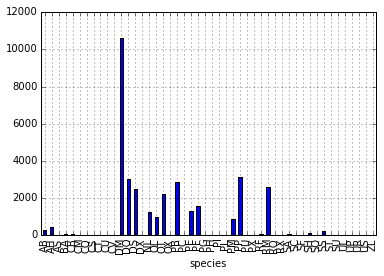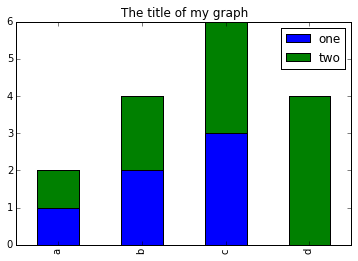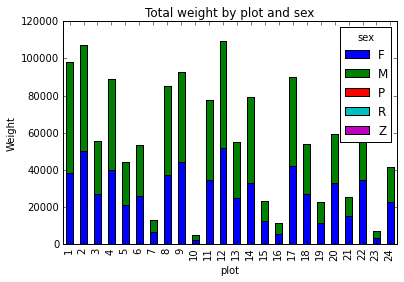Overview
Teaching: 0 min
Exercises: 0 minQuestions
Objectives
Navigate the workshop directory and download a dataset.
Explain what a library is and what libraries are used for.
Describe what the Python Data Analysis Library (Pandas) is.
Load the Python Data Analysis Library (Pandas).
Use
read_csvto read tabular data into Python.Describe what a DataFrame is in Python.
Access and summarize data stored in a DataFrame.
Define indexing as it relates to data structures.
Perform basic mathematical operations and summary statistics on data in a Pandas DataFrame.
Create simple plots.
Working With Pandas DataFrames in Python
We can automate the process above using Python. It’s efficient to spend time building the code to perform these tasks because once it’s built, we can use it over and over on different datasets that use a similar format. This makes our methods easily reproducible. We can also easily share our code with colleagues and they can replicate the same analysis.
Starting in the same spot
To help the lesson run smoothly, let’s ensure everyone is in the same directory. This should help us avoid path and file name issues. At this time please navigate to the workshop directory. If you working in IPython Notebook be sure that you start your notebook in the workshop directory.
A quick aside that there are Python libraries like OS Library that can work with our directory structure, however, that is not our focus today.
Our Data
For this lesson, we will be using the Portal Teaching data, a subset of the data from Ernst et al Long-term monitoring and experimental manipulation of a Chihuahuan Desert ecosystem near Portal, Arizona, USA
We will be using files from the Portal Project Teaching Database.
This section will use the surveys.csv file that can be downloaded here:
https://ndownloader.figshare.com/files/2292172
We are studying the species and weight of animals caught in plots in our study
area. The dataset is stored as a .csv file: each row holds information for a
single animal, and the columns represent:
| Column | Description |
|---|---|
| record_id | Unique id for the observation |
| month | month of observation |
| day | day of observation |
| year | year of observation |
| plot_id | ID of a particular plot |
| species_id | 2-letter code |
| sex | sex of animal (“M”, “F”) |
| hindfoot_length | length of the hindfoot in mm |
| weight | weight of the animal in grams |
The first few rows of our first file look like this:
record_id,month,day,year,plot_id,species_id,sex,hindfoot_length,weight
1,7,16,1977,2,NL,M,32,
2,7,16,1977,3,NL,M,33,
3,7,16,1977,2,DM,F,37,
4,7,16,1977,7,DM,M,36,
5,7,16,1977,3,DM,M,35,
6,7,16,1977,1,PF,M,14,
7,7,16,1977,2,PE,F,,
8,7,16,1977,1,DM,M,37,
9,7,16,1977,1,DM,F,34,
About Libraries
A library in Python contains a set of tools (called functions) that perform tasks on our data. Importing a library is like getting a piece of lab equipment out of a storage locker and setting it up on the bench for use in a project. Once a library is set up, it can be used or called to perform many tasks.
Pandas in Python
One of the best options for working with tabular data in Python is to use the Python Data Analysis Library (a.k.a. Pandas). The Pandas library provides data structures, produces high quality plots with matplotlib and integrates nicely with other libraries that use NumPy (which is another Python library) arrays.
Python doesn’t load all of the libraries available to it by default. We have to
add an import statement to our code in order to use library functions. To import
a library, we use the syntax import libraryName. If we want to give the
library a nickname to shorten the command, we can add as nickNameHere. An
example of importing the pandas library using the common nickname pd is below.
import pandas as pd
Each time we call a function that’s in a library, we use the syntax
LibraryName.FunctionName. Adding the library name with a . before the
function name tells Python where to find the function. In the example above, we
have imported Pandas as pd. This means we don’t have to type out pandas each
time we call a Pandas function.
Reading CSV Data Using Pandas
We will begin by locating and reading our survey data which are in CSV format.
We can use Pandas’ read_csv function to pull the file directly into a
DataFrame.
So What’s a DataFrame?
A DataFrame is a 2-dimensional data structure that can store data of different
types (including characters, integers, floating point values, factors and more)
in columns. It is similar to a spreadsheet or an SQL table or the data.frame in
R. A DataFrame always has an index (0-based). An index refers to the position of
an element in the data structure.
# note that pd.read_csv is used because we imported pandas as pd
pd.read_csv("surveys.csv")
The above command yields the output below:
record_id month day year plot_id species_id sex hindfoot_length weight
0 1 7 16 1977 2 NL M 32 NaN
1 2 7 16 1977 3 NL M 33 NaN
2 3 7 16 1977 2 DM F 37 NaN
3 4 7 16 1977 7 DM M 36 NaN
4 5 7 16 1977 3 DM M 35 NaN
...
35544 35545 12 31 2002 15 AH NaN NaN NaN
35545 35546 12 31 2002 15 AH NaN NaN NaN
35546 35547 12 31 2002 10 RM F 15 14
35547 35548 12 31 2002 7 DO M 36 51
35548 35549 12 31 2002 5 NaN NaN NaN NaN
[35549 rows x 9 columns]
We can see that there were 33,549 rows parsed. Each row has 9
columns. The first column is the index of the DataFrame. The index is used to
identify the position of the data, but it is not an actual column of the DataFrame.
It looks like the read_csv function in Pandas read our file properly. However,
we haven’t saved any data to memory so we can work with it.We need to assign the
DataFrame to a variable. Remember that a variable is a name for a value, such as x,
or data. We can create a new object with a variable name by assigning a value to it using =.
Let’s call the imported survey data surveys_df:
surveys_df = pd.read_csv("surveys.csv")
Notice when you assign the imported DataFrame to a variable, Python does not
produce any output on the screen. We can print the value of the surveys_df
object by typing its name into the Python command prompt.
surveys_df
which prints contents like above
Manipulating Our Species Survey Data
Now we can start manipulating our data. First, let’s check the data type of the
data stored in surveys_df using the type method. The type method and
__class__ attribute tell us that surveys_df is <class 'pandas.core.frame.DataFrame'>.
type(surveys_df)
# this does the same thing as the above!
surveys_df.__class__
We can also enter surveys_df.dtypes at our prompt to view the data type for each
column in our DataFrame. int64 represents numeric integer values - int64 cells
can not store decimals. object represents strings (letters and numbers). float64
represents numbers with decimals.
surveys_df.dtypes
which returns:
record_id int64
month int64
day int64
year int64
plot_id int64
species_id object
sex object
hindfoot_length float64
weight float64
dtype: object
We’ll talk a bit more about what the different formats mean in a different lesson.
Useful Ways to View DataFrame objects in Python
There are multiple methods that can be used to summarize and access the data
stored in DataFrames. Let’s try out a few. Note that we call the method by using
the object name surveys_df.method. So surveys_df.columns provides an index
of all of the column names in our DataFrame.
Challenges
Try out the methods below to see what they return.
surveys_df.columns.surveys_df.head(). Also, what doessurveys_df.head(15)do?surveys_df.tail().surveys_df.shape. Take note of the output of the shape method. What format does it return the shape of the DataFrame in?
HINT: More on tuples, here.
Calculating Statistics From Data In A Pandas DataFrame
We’ve read our data into Python. Next, let’s perform some quick summary statistics to learn more about the data that we’re working with. We might want to know how many animals were collected in each plot, or how many of each species were caught. We can perform summary stats quickly using groups. But first we need to figure out what we want to group by.
Let’s begin by exploring our data:
# Look at the column names
surveys_df.columns.values
which returns:
array(['record_id', 'month', 'day', 'year', 'plot_id', 'species_id', 'sex',
'hindfoot_length', 'weight'], dtype=object)
Let’s get a list of all the species. The pd.unique function tells us all of
the unique values in the species_id column.
pd.unique(surveys_df['species_id'])
which returns:
array(['NL', 'DM', 'PF', 'PE', 'DS', 'PP', 'SH', 'OT', 'DO', 'OX', 'SS',
'OL', 'RM', nan, 'SA', 'PM', 'AH', 'DX', 'AB', 'CB', 'CM', 'CQ',
'RF', 'PC', 'PG', 'PH', 'PU', 'CV', 'UR', 'UP', 'ZL', 'UL', 'CS',
'SC', 'BA', 'SF', 'RO', 'AS', 'SO', 'PI', 'ST', 'CU', 'SU', 'RX',
'PB', 'PL', 'PX', 'CT', 'US'], dtype=object)
Challenges
-
Create a list of unique plot ID’s found in the surveys data. Call it
plot_names. How many unique plots are there in the data? How many unique species are in the data? -
What is the difference between
len(plot_names)andplot_names.nunique()?
Groups in Pandas
We often want to calculate summary statistics grouped by subsets or attributes within fields of our data. For example, we might want to calculate the average weight of all individuals per plot.
We can calculate basic statistics for all records in a single column using the syntax below:
surveys_df['weight'].describe()
gives output
count 32283.000000
mean 42.672428
std 36.631259
min 4.000000
25% 20.000000
50% 37.000000
75% 48.000000
max 280.000000
Name: weight, dtype: float64
We can also extract one specific metric if we wish:
surveys_df['weight'].min()
surveys_df['weight'].max()
surveys_df['weight'].mean()
surveys_df['weight'].std()
surveys_df['weight'].count()
But if we want to summarize by one or more variables, for example sex, we can
use Pandas’ .groupby method. Once we’ve created a groupby DataFrame, we
can quickly calculate summary statistics by a group of our choice.
# Group data by sex
sorted_data = surveys_df.groupby('sex')
The Pandas function describe will return descriptive stats including: mean,
median, max, min, std and count for a particular column in the data. Pandas’
describe function will only return summary values for columns containing
numeric data.
# summary statistics for all numeric columns by sex
sorted_data.describe()
# provide the mean for each numeric column by sex
sorted_data.mean()
sorted_data.mean() OUTPUT:
record_id month day year plot_id \
sex
F 18036.412046 6.583047 16.007138 1990.644997 11.440854
M 17754.835601 6.392668 16.184286 1990.480401 11.098282
hindfoot_length weight
sex
F 28.836780 42.170555
M 29.709578 42.995379
The groupby command is powerful in that it allows us to quickly generate
summary stats.
Challenge
- How many recorded individuals are female
Fand how many maleM - What happens when you group by two columns using the following syntax and
then grab mean values:
sorted_data2 = surveys_df.groupby(['plot_id','sex'])sorted_data2.mean()
- Summarize weight values for each plot in your data. HINT: you can use the
following syntax to only create summary statistics for one column in your data
by_plot['weight'].describe()
Did you get #3 right? A Snippet of the Output from challenge 3 looks like:
plot
1 count 1903.000000
mean 51.822911
std 38.176670
min 4.000000
25% 30.000000
50% 44.000000
75% 53.000000
max 231.000000
...
Quickly Creating Summary Counts in Pandas
Let’s next count the number of samples for each species. We can do this in a few
ways, but we’ll use groupby combined with a count() method.
# count the number of samples by species
species_counts = surveys_df.groupby('species_id')['record_id'].count()
Or, we can also count just the rows that have the species “DO”:
surveys_df.groupby('species_id')['record_id'].count()['DO']
Basic Math Functions
If we wanted to, we could perform math on an entire column of our data. For example let’s multiply all weight values by 2. A more practical use of this might be to normalize the data according to a mean, area, or some other value calculated from our data.
# multiply all weight values by 2
surveys_df['weight']*2
Another Challenge
- What’s another way to create a list of species and associated
countof the records in the data? Hint: you can performcount,min, etc functions on groupby DataFrames in the same way you can perform them on regular DataFrames.
Quick & Easy Plotting Data Using Pandas
We can plot our summary stats using Pandas, too.
# make sure figures appear inline in Ipython Notebook
%matplotlib inline
# create a quick bar chart
species_counts.plot(kind='bar');
 Weight by species plot
Weight by species plot
We can also look at how many animals were captured in each plot:
total_count = surveys_df['record_id'].groupby(surveys_df['plot_id']).nunique()
# let's plot that too
total_count.plot(kind='bar');
Challenge Activities
- Create a plot of average weight across all species per plot.
- Create a plot of total males versus total females for the entire dataset.
Summary Plotting Challenge
Create a stacked bar plot, with weight on the Y axis, and the stacked variable being sex. The plot should show total weight by sex for each plot. Some tips are below to help you solve this challenge:
- For more on Pandas plots, visit this link.
- You can use the code that follows to create a stacked bar plot but the data to stack need to be in individual columns. Here’s a simple example with some data where ‘a’, ‘b’, and ‘c’ are the groups, and ‘one’ and ‘two’ are the subgroups.
d = {'one' : pd.Series([1., 2., 3.], index=['a', 'b', 'c']),'two' : pd.Series([1., 2., 3., 4.], index=['a', 'b', 'c', 'd'])}
pd.DataFrame(d)
shows the following data
one two
a 1 1
b 2 2
c 3 3
d NaN 4
We can plot the above with
# plot stacked data so columns 'one' and 'two' are stacked
my_df = pd.DataFrame(d)
my_df.plot(kind='bar',stacked=True,title="The title of my graph")

- You can use the
.unstack()method to transform grouped data into columns for each plotting. Try running.unstack()on some DataFrames above and see what it yields.
Start by transforming the grouped data (by plot and sex) into an unstacked layout, then create a stacked plot.
Solution to Summary Challenge
First we group data by plot and by sex, and then calculate a total for each plot.
by_plot_sex = surveys_df.groupby(['plot_id','sex'])
plot_sex_count = by_plot_sex['weight'].sum()
This calculates the sums of weights for each sex within each plot as a table
plot sex
plot_id sex
1 F 38253
M 59979
2 F 50144
M 57250
3 F 27251
M 28253
4 F 39796
M 49377
<other plots removed for brevity>
Below we’ll use .unstack() on our grouped data to figure out the total weight that each sex contributed to each plot.
by_plot_sex = surveys_df.groupby(['plot_id','sex'])
plot_sex_count = by_plot_sex['weight'].sum()
plot_sex_count.unstack()
The unstack function above will display the following output:
sex F M
plot_id
1 38253 59979
2 50144 57250
3 27251 28253
4 39796 49377
<other plots removed for brevity>
Now, create a stacked bar plot with that data where the weights for each sex are stacked by plot.
Rather than display it as a table, we can plot the above data by stacking the values of each sex as follows:
by_plot_sex = surveys_df.groupby(['plot_id','sex'])
plot_sex_count = by_plot_sex['weight'].sum()
spc = plot_sex_count.unstack()
s_plot = spc.plot(kind='bar',stacked=True,title="Total weight by plot and sex")
s_plot.set_ylabel("Weight")
s_plot.set_xlabel("Plot")

Key Points